
Students will create a compilation of 20 images from the 1960s and explain the significance of each image.
- Subject:
- History
- Material Type:
- Activity/Lab
- Assessment
- Diagram/Illustration
- Date Added:
- 07/14/2017

Students will create a compilation of 20 images from the 1960s and explain the significance of each image.

The purpose of this course is to examine the African American experience in the United States from 1863 to the present. Prominent themes include the end of the Civil War and the beginning of Reconstruction; African Americans' urbanization experiences; the development of the modern civil rights movement and its aftermath; and the thought and leadership of Booker T. Washington, Ida B. Wells-Barnett, W.E.B. Du Bois, Marcus Garvey, Martin Luther King Jr., and Malcolm X. WARNING: Some of the lectures in this course contain graphic content and/or adult language that some users may find disturbing.
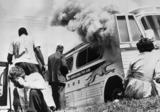
OYH Multimedia Anthologies anthologies collect a range of materials for exploring OYH topics. They parallel and supplement the OYHL school modules, available as Open Education Resources. . Groups of all ages can explore & discuss these rich and varied collections for sharing reflections on aspects of U.S. history and deepening historical knowledge. They are also available through the OYH website, https://www.ownyourhistory.us/multimediaresourcesIn US history, land ownership provides family security and cohesion, wealth accumulation, and social advancement. American law supports these goals for most Americans, but often not for Black Americans or other communities of color. The 1960s Civil Rights Movement led to some positive changes, but inequality continues. This module primarily examines housing and financing discrimination affecting urban Black families, in urban areas, it briefly considers rural Black property ownership.The resource focuses on housing and real property ownership because of the important role of a home as a basis for economic security, wealth creation, family relationships and stability.
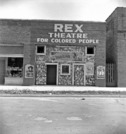
In US history, land ownership provides family security and cohesion, wealth accumulation, and social advancement. The American law supports these goals for most Americans, but often not for Black Americans or other communities of color. The 1960s Civil Rights Movement led to some positive changes, but inequality continues. This module primarily examines housing and financing discrimination affecting urban Black families, in urban areas, it briefly considers rural Black property ownership.The module focuses on housing and real property ownership because of the important role of a home as a basis for economic security, wealth creation, family relationships and stability. The country has a substantial social investment in existing housing and the color-based housing patterns that still result in significant segregation in most cities. It asks how to move toward a legal system, housing policies and practices of genuine equality, opportunity, and freedom for all without separation by color in our cities and communities. While not addressing reparations for inequalities from enslavement and segregation, it asks students to develop proposals addressing such inequalities.

This course examines the social, cultural, political, and economic history of the United States, from the Civil War to the present. It uses secondary analysis and primary documents, such as court cases, personal accounts, photographs, and films, to examine some of the key issues in the shaping of modern America, including industrialization and urbanization, immigration, the rise of a mass consumer society, the emergence of the US as a global power, and the development of civil rights activism and other major social movements.

In this lesson, students will examine the history and popularity of "We Shall Overcome" and investigate six additional songs from different musical genres that reveal the impact of the Civil Rights movement. These are: Billie Holiday's "Strange Fruit," a poignant Blues song depicting the horrors of lynching; Bob Dylan's "Oxford Town," a Folk song about protests after the integration of the University of Mississippi; John Coltrane's "Alabama," an instrumental Jazz recording made in response to the September 1963 church bombing in Birmingham, Alabama, that killed four African-American girls; Nina Simone's "Mississippi Goddam," a response to the same church bombing as well as the murder of civil rights activist Medgar Evers in Mississippi; Sam Cooke's "A Change is Gonna Come," a Soul song written after Cooke's arrest for attempting to check in to a whites-only motel in Shreveport, Louisiana; and Odetta's "Oh Freedom," a spiritual that Odetta performed at the 1963 March on Washington.
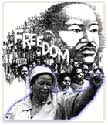
This resource contains some powerpoint slides, google slides, videos, images and worksheets that focus on the civil society protests. It is for specifically designed for Grade 12 learners.
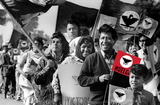
Own Your History® Multimedia Anthologies -- These anthologies collect a range of materials for exploring OYH topics. They parallel and supplement the OYH school modules, available as Open Education Resources. Groups of all ages can explore & discuss these rich and varied collections for sharing reflections on aspects of U.S. history and deepening historical knowledge. They are also available through the OYH website, https://www.ownyourhistory.us/multimediaresources Until La Causa, California farmworkers lived and worked in deplorable, often inhumane, conditions, at the mercy of growers. Spanish-speaking migrant minorities, they were socially invisible to the country. La Causa used bold nonviolent methods and community involvement to achieve change & personal dignity. Explore this history using the links in the attachment.

Until La Causa, California farmworkers lived and worked in deplorable, often inhumane, conditions, at the mercy of growers. Spanish-speaking migrant minorities, they were socially invisible to the country. La Causa used bold nonviolent methods and community involvement to achieve change & personal dignity. Explore this history using the lessons and links below.
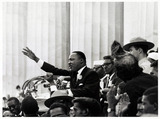
These anthologies parallel and supplement the OYH school modules, available as Open Education Resources. Groups of all ages can explore & discuss these collections. Also available through the OYH website, https://www.ownyourhistory.us/multimediaresourcesThis anthology focuses on the strategies and methods used in the 1960s by Black Americans to challenge Jim Crow segregation and to put equal rights and opportunities on the nation’s agenda. They called into question the subordination of Blacks and other people of color based upon racist views. Young, new leaders undertook nonviolent direct-action protests supported by Black religious organizations and studentsin the face of determined opposition and violence by Southern Whites. By 1965, the federal government responded by passing historic civil rights and voting rights legislation.These landmark accomplishments did not address economic inequalities. Urban uprisings in 1967-68 were fueled by these economic inequalities and the assassination of Dr. King. President Johnson appointed a commission led Otto Kerner to examine these uprisings and make recommendations.
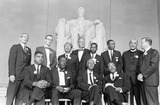
Until about 1966, the Civil Rights Movement led by Dr. King and the other national Black organizations focused on ending segregation, changing racist attitudes, advancing equality under the law, and securing the vote. Because of the system of Jim Crow laws, the Movement’s attention was largely on the South. Protests also highlighted economic inequalities and jobs and demanded government responses to effect change. In the “long hot summer” of 1967, over 20 uprisings and disorders took place in cities across the country. This prompted President Johnson to appoint a study commission led by former Illinois Governor Otto Kerner to examine these uprisings and make recommendations. Additional rioting occurred in 1968 in reaction to the assassination of Dr. King. The 1968 Kerner Commission report is a detailed, thoughtful, and clear-eyed analysis of these urban disorders with a comprehensive and bold set of recommendations for addressing systemic racism and its economic and social consequences.
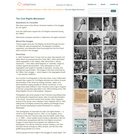
In 1948, President Harry Truman took an early step towards civil rights reform by issuing Executive Order 9981, which eliminated racial segregation in the military. After World War II, African Americans ? then often called Negroes or "coloreds," began to mobilize against discrimination. They demanded an end to segregation and fought for equality in education, housing, and employment opportunities. The images in this topic show that by the 1960s, their struggle ? which began in the segregated South ? had reached California. As a number of photographs in this topic show, many Californians showed their support for Civil Rights activists and victims of racial discrimination in the South by holding marches, rallies, and demonstrations urging equality for African Americans. In one image three white children in San Francisco hold a sign in support of the four young black girls killed in the 1963 bombing of the 16th Street Baptist Church in Birmingham, Alabama. Photographs also show people in San Francisco boycotting Kress and Woolworth's department stores, sites of racial discrimination in the South. Documents shown here include a flyer urging the boycott of the stores; and a Western Union telegram sent in 1963, stating that Civil Rights activists Roy Wilkins and Medgar Evers were arrested attempting to picket Woolworth's in Jackson, Mississippi. Two photographs of memorials for slain civil rights leaders ? a march in honor Medgar Evers in 1963, in Los Angeles, and a memorial in the San Francisco Bay Area for Martin Luther King, Jr., in 1968 ? show racially mixed crowds in attendance. But not all Californians sympathized with the Civil Rights movement. Images of racial hatred and prejudice are reflected in the photograph of an African American woman holding a rock that had been thrown through an office window, and Klu Klux Klan graffiti spray-painted on a home. Various groups formed to fight in the struggle for equal rights. The National Association for the Advancement of Colored People (NAACP), formed in 1909, entered a new phase during this period, leading in the organized struggle for civil rights. An example of how the NAACP communicated about events is reflected in a letter from the Alameda County branch of the NAACP on June 13, 1950, which reported segregation on the Southern Pacific Railroad trains leaving Los Angeles. A flyer promoting the boycott of California grapes exemplifies NAACP support for other rights movements, in this case the United Farm Workers. Other flyers urged Californians to fight sharecropper wages and "Keep Mississippi Out of California." Groups such as the Congress of Racial Equality (CORE) and student groups also protested segregation and incidents of racial discrimination in the South. Several important African American leaders ? including Martin Luther King, Jr., Malcolm X, Thurgood Marshall, and Ralph Abernathy ? all came to California, as documented by photographs included here. Sometimes, the price of fighting for social justice was high. Two images capture events held for leaders in the social justice movement who were assassinated: the 1963 memorial march in Los Angeles for civil rights leader Medgar Evers; and a crowd attending a Martin Luther King, Jr., Memorial Rally in honor of the slain civil rights leader.

The 1930s were a nadir for Black Americans. Systemic segregation, subordination & economic privation were prevalent In American society nationwide. White Southern political power blocked New Deal benefits. Use the links to explore this history and the ways Black Americans increasingly took risks to more forcefully advocate for justice & equality.Civil rights fwas not on the national agenda in the 1930s. Segregation and subordination of Black Americans were firmly rooted throughout American society and the country. The Great Depression and later the emerging war crisis in Europe dominated national attention. Southerners in Congress opposed changes to help Black Americans, including anti-lynching bills, and amended New Deal legislation to deny Black Americans the benefits and programs being offered to white citizens. A core topic of this resource is risk-taking, primarily by Marian Anderson, A. Philip Randolph, and Eleanor Roosevelt in publicly seeking to achieve greater rights for Black Americans .Their goals were modest by today’s standards, but their actions were historic.
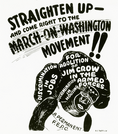
Civil rights for Black Americans was not on the national agenda in the 1930s. Segregation and subordination of Black Americans were firmly rooted throughout American society and in all parts of the country. The Great Depression and later the emerging war crisis in Europe dominated national attention. Southerners in Congress opposed changes to help Black Americans, including anti-lynching bills, and amended New Deal legislation to deny Black Americans the benefits and programs being offered to white citizens. This module examines the leadership of three very different Americans—First Lady Eleanor Roosevelt, world-renowned contralto Marian Anderson, and labor leader A. Philip Randolph. They each shared strong inner voices, an ability to imagine a world beyond the bounds allowed by the politics and society of their day, and a willingness to take risks for controversial civil rights advances in which they believed—all at a time when segregation and Black American deprivation were central aspects of American society in every part of the country.
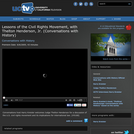
Conversations host Harry Kreisler welcomes Judge Thelton Henderson for a discussion of the U.S. civil rights movement and its implications for international law. (43 min)
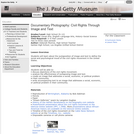
Students will learn about the juxtaposition of image and text to define the social and psychological mood of the civil rights movement in the United States.
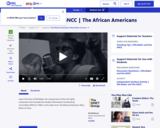
Learn the story of Ella Baker, the unsung hero of the civil rights movement who founded the Student Nonviolent Coordinating Committee (SNCC) in 1960, in this video from The African Americans: Many Rivers to Cross.

Nikki Giovanni's poem 'The Funeral of Martin Luther King, Jr.' is paired with Dr. King's "I Have a Dream" speech, taking students on a quest through time to the Civil Rights movement.

This collection uses primary sources to explore The Fire Next Time by James Baldwin. Digital Public Library of America Primary Source Sets are designed to help students develop their critical thinking skills and draw diverse material from libraries, archives, and museums across the United States. Each set includes an overview, ten to fifteen primary sources, links to related resources, and a teaching guide. These sets were created and reviewed by the teachers on the DPLA's Education Advisory Committee.

In this lesson, students will use a primary source—an NBC news report from 1961—to investigate the Freedom Rides. The lesson will also explore segregation in the South and the tenets of nonviolent protest.